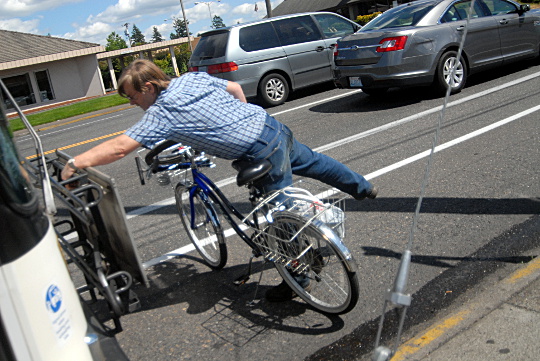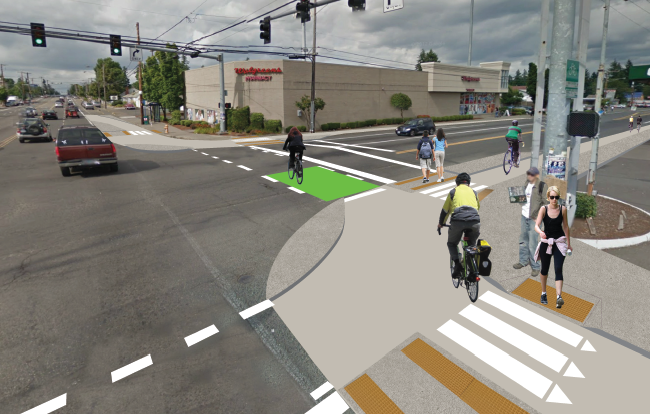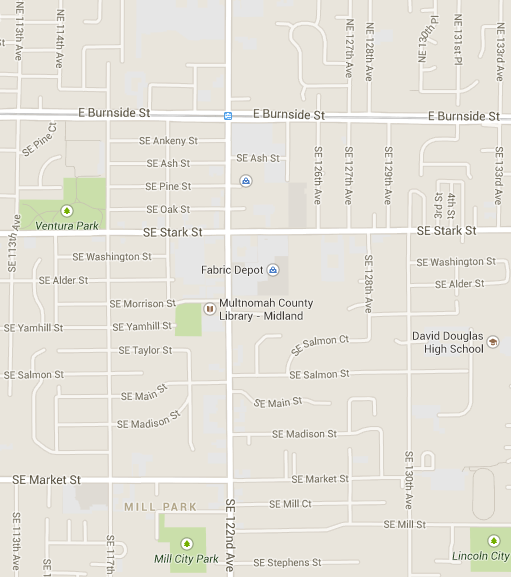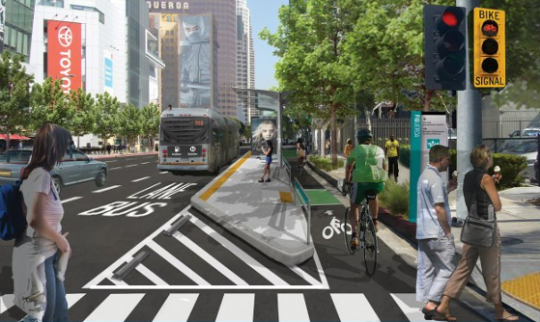122nd Avenue is part of Portland. But it doesn’t look like “Portland.”
Instead, it looks like America. And that means it’s a pretty big opportunity.
With two travel lanes in each direction, a center turn lane, a pair of door-zone bike lanes that sometimes squeeze narrower than four feet and a little-used parking lane along the curb, east Portland’s most important artery would look right at home in Albuquerque, Kansas City, Columbus, Rochester or Greensboro.

(Image: Streetmix.net)
But what if 122nd Avenue were different? What if, here outside Portland’s historic street grid, where almost every trip has to use a massive artery like this one because the side streets don’t connect, we could find a way to serve not only the 85 percent of east Portland households that own cars, but the 15 percent that don’t?
What if you could use 122nd Avenue’s great problem — its huge, empty expanses of pavement — to turn it into a place where getting around without a car feels like something other than a hassle, a burden or a shame?
If you could do that, you’d have more than just a great place for Portlanders to live, work and do business. You’d have a template.

Some people say Portland doesn’t need the physically separated bike lanes that San Francisco, Boston and Indianapolis have been building rapidly: that our neighborhood greenway network and our narrow, stoplight-calmed downtown streets are good enough for everyone who might ride a bicycle. But even if that’s the case in the central city, east Portland is an entirely different story.
Advertisement
These were the ideas that about 25 Portlanders, two North Carolinians, one Oregon City visitor and I tackled early Sunday evening on Bizarro 122nd Avenue, a PedalPalooza ride down 122nd that invited people to think about an alternate-universe version of the street. Here’s what we asked:
What if the city connected more of the private parking lots that line this street, removing some of the many driveway entrances and reducing the constant danger of turning cars?
What if the city eliminated the almost completely unused on-street parking lane and used the space for a six-foot-wide bike lane separated from traffic by bollards or curbs?
What if, like the soon-to-be redesigned Figueroa Street in South Los Angeles, the city moved stops for a newly frequent bus line onto platforms to the left of the bike lane, so buses could stop and start quickly, comfortably and without constantly zigzagging across the bike lane?
What if, at major intersections like Division and Powell, the city removed its scary sharrow-marked turn lanes and instead added eyelet-shaped curbs that created protected intersections where two sets of protected bike lanes could safely and intuitively intersect without preventing right-turning car traffic?


(Rendering by Nick Falbo)
Along the way, we looked at some of the things that are making the 122nd Avenue area better: the new flashing crosswalk beacon outside Midland Library, the busy but calmingly narrow Burnside Street, the eight-foot buffered bike lanes on Southeast Holgate. Many of the participants, a mix of curious bike-lovers, dedicated transportation wonks and interested locals, joined in with questions or additions. And afterward we headed west on the Springwater Corridor for beers and dinner at Cartlandia, the thriving multicultural food cart pod outside Lents.
On Friday, a few days before Sunday’s ride, I’d called Portland Bicycle Planning Coordinator Roger Geller to ask what possibilities he saw for 122nd. North of Powell, he said, converting the unused parking lanes to high-quality bike lanes was the most viable option for the street; south of Powell, traffic is low enough that the road could probably be narrowed to two travel lanes, a turn lane, bike lanes and parking lanes without much congestion.
“But we haven’t really looked at it that much,” he noted.
Projects of this scale would cost millions of dollars. Geller’s bureau currently has $1 million a year to spend on all street safety projects citywide.
But according to Geller’s calculations, east Portland has great potential for biking, in part because so many people who live here can’t afford to own cars. If biking could be made safer, more comfortable and less stigmatized, bikes could be a very popular way to get around.
Today, about 1 percent of commute trips east of 82nd Avenue happen on a bicycle. Geller said travel behavior data from cities with low-stress bike networks shows that this could increase to about 15 percent of work trips with a complete network of protected bike lanes and neighborhood greenways.
If hubs like Gateway, Midway or Lents became job centers, Geller said, that figure would be even higher.
What about the notion that east Portlanders don’t want to dedicate road space to high-quality bike lanes? Geller said he likes to look at a the steady flow of people here who ride their bicycles on the sidewalk — using the only available separation between bikes and cars.
“To my mind that just says, ‘These are people who want a cycle track,'” Geller said.






